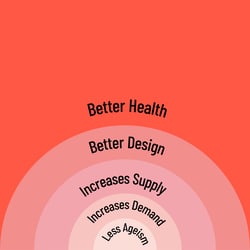Guest article: Why we need to demand desirable design for our ageing population
In an exclusive article for THIIS, Carly Dickson, Knowledge Exchange Fellow at Design Age Institute at the Royal College of Art explores why we need to demand desirable design for our ageing population…
Take a moment to think about all the ways you want to spend your time in the future. Imagine the last decade of your life.
Do you want to have desirable choices for how you spend your time, who you spend it with, and where? Do you want the same for your loved ones? And for society?
If the answer is yes, this is why we all need to demand desirable design for our ageing population – we are our ageing population. If we design desirable choices of products, services, and environments that help us age well, we will benefit as individuals and as a society, today and in the future.
How would you feel if design prevented you from spending your time how you wish? This is a reality for many people who are excluded by design.
“What are the design assumptions at work here? Do we care whom we are including — and whom we are excluding — by our design choices?”
— Shefaly Yogendra, The age of un-empathy
Bad design due to lack of access, lack of inclusion, lack of safety, or lack of joy, often disproportionately impacts older people (who will make up 24 per cent of the UK population by 2043) and disabled people (who make up 22 per cent of the UK population based on those who reported a disability in 2020-21). For example, lack of accessible, affordable, or comfortable transport and travel options exclude people from participating in society and in the economy, a study has found.
In Design Age Institute’s new report ‘Design Age Ideas’ we explore how, whether as designers or as users, consumers, and citizens, we can learn to ban ageist assumptions, think critically about bad design, think collaboratively about better design, in order to actively demand desirable design for an age-inclusive society that benefits us all.
Our partners at Oxford Institute for Population Ageing have termed this ‘a century of centenarians’ that many of us may get to enjoy if we’re lucky. At Design Age Institute, we want to reduce the amount of luck needed. As a team of designers and design researchers, we can’t change the luck of the draw in terms of genetic or hereditary dispositions, but we can improve our exposures and the choices available around us.
- Exposures: If we can design inclusive, walkable communities that give us access to social connections, purposeful activities, and nature, we will increase our exposure to environments that benefit our health
- Choices: If we can design more desirable healthy options, people will be more motivated to make the healthy choice
How to design age better? Ban assumptions and design together
If we know there are risks of bad design, how can we design for our ageing better?
Designers can’t and shouldn’t design the products, services, and environments we are exposed to and the choices we have all on their own. If we don’t engage with real older people in the design process, we are more at risk of letting our assumptions influence design decisions. Our partners at the International Longevity Centre UK (ILC-UK) found that
“Market research into older consumers is weak. Segmentation by age is poor, normally grouping together all consumers aged over 65. This severely restricts marketing possibilities.”
Whether you are responsible for creating design or not, we all are impacted by how design does or does not respond to what we want and need. To reduce the risk of ageist assumptions and stereotypes driving decisions, it is important older people’s voices are involved and heard in the design process.
The more designers engage with users, consumers, and citizens with diverse lived experiences, the better we can understand the diverse needs and want any given design needs to take into account.
Undo ageism to unlock desirable design
The ‘Design Age Ideas’ report explores how unlocking desirable design may begin by undoing ageism. We see ageism as a root cause that starts a negative cycle:
- Ageism leads to limited demand due to lack of exposure
- Lack of demand leads to limited supply due to lack of perceived need or want
- Limited supply provides bad or no design options
- This reduces the opportunity for health-benefiting outcomes
+. This proliferating cycle causes a negative ripple effect
The good news is design can be an important lever to break vicious cycles and catalyse virtuous circles that promote healthier, happier ageing:
- Less ageism can increase demand due to increased exposure to diverse realities of later life
- This increased exposure leads to increased supply due to a better understanding of real needs and wants
- This increased supply provides better and more design choices
- This increases the opportunity for health-benefiting outcomes
For example, research has found access to inclusive parks where people of all ages can come together over common interests begins to break down ageist stereotypes and reveals the benefits of designing desirable places for people of all ages.
This can undo negative cycles and start a positive effect. Better design of desirable products, services, and environments can help reduce ageist stereotypes, increase demand, and therefore increase supply for a rapidly growing number of people. By demanding and advocating for inclusive design policies and processes we can better understand design’s role in reducing health inequalities and increasing a sense of belonging, purpose, and choice.
We all have a unique experience of the world – we benefit when design responds to diversity. If design excludes or harms people, we should blame it, name it as bad design, and demand better.
Read Design Age Institute’s new report ‘Design Age Ideas’ here.





